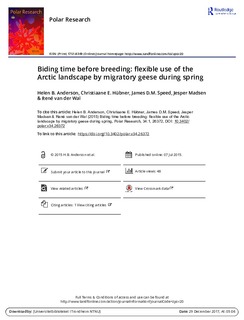| dc.contributor.author | Anderson, Helen | |
| dc.contributor.author | Hübner, Christiane E. | |
| dc.contributor.author | Speed, James David Mervyn | |
| dc.contributor.author | Madsen, Jesper | |
| dc.contributor.author | van der Wal, René | |
| dc.date.accessioned | 2018-01-02T12:29:04Z | |
| dc.date.available | 2018-01-02T12:29:04Z | |
| dc.date.created | 2015-07-08T09:20:51Z | |
| dc.date.issued | 2015 | |
| dc.identifier.citation | Polar Research. 2015, 34 . | nb_NO |
| dc.identifier.issn | 0800-0395 | |
| dc.identifier.uri | http://hdl.handle.net/11250/2474040 | |
| dc.description.abstract | Many millions of long-distance migrants use pre-breeding staging sites located adjacent to breeding grounds immediately prior to nesting, presumably to improve body condition and thus reproductive success. However, in highly seasonal landscapes such as the High Arctic, early spring feeding opportunities are limited and time to complete the breeding cycle is short. Hence, a more productive strategy may be to initiate breeding as soon as local conditions allow. We used remote sensing satellite imagery combined with field-based methods to demonstrate flexible responses to local environmental conditions by Svalbard pink-footed geese (Anser brachyrhynchus), an abundant long-distance migratory herbivore. Satellite imagery revealed greater snow cover at the main nesting area in central Svalbard than at the adjacent pre-breeding staging site when snowmelt was late, with greater numbers of geese using the pre-breeding site. When snowmelt was early, however, snow cover at the main nesting area was lower than in years with late snowmelt and significantly fewer pink-footed geese used the pre-breeding site under such conditions. The response of geese to differing snowmelt conditions demonstrates flexibility in their use of the landscape, suggesting that pre-breeding sites are used primarily as a stop-gap in those years when snowmelt is late and nest sites inaccessible. | nb_NO |
| dc.language.iso | eng | nb_NO |
| dc.publisher | Taylor & Francis | nb_NO |
| dc.rights | Navngivelse-Ikkekommersiell 4.0 Internasjonal | * |
| dc.rights.uri | http://creativecommons.org/licenses/by-nc/4.0/deed.no | * |
| dc.title | Biding time before breeding: flexible use of the Arctic landscape by migratory geese during spring | nb_NO |
| dc.type | Journal article | nb_NO |
| dc.type | Peer reviewed | nb_NO |
| dc.description.version | publishedVersion | nb_NO |
| dc.source.pagenumber | 5 | nb_NO |
| dc.source.volume | 34 | nb_NO |
| dc.source.journal | Polar Research | nb_NO |
| dc.identifier.doi | 10.3402/polar.v34.26372 | |
| dc.identifier.cristin | 1252888 | |
| dc.description.localcode | © 2015 H.B. Anderson et al. This is an Open Access article distributed under the terms of the Creative Commons Attribution-NonCommercial 4.0 International License (http://creativecommons.org/licenses/by-nc/4.0/) | nb_NO |
| cristin.unitcode | 194,31,10,0 | |
| cristin.unitname | Institutt for naturhistorie | |
| cristin.ispublished | true | |
| cristin.fulltext | original | |
| cristin.qualitycode | 1 | |

